

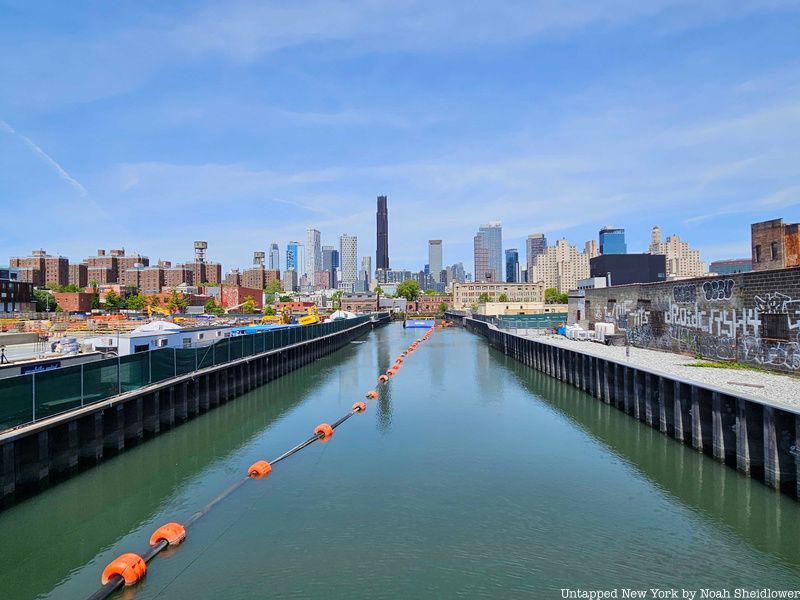
Gowanus is one of Brooklyn’s more eccentric neighborhoods, with a relatively younger crowd tucked into blocks of industrial properties. Amid former factories and abandoned buildings, there are art centers, breweries, rock-climbing facilities, and even a shuffleboard club. Located near Red Hook and Carroll Gardens, Gowanus is known for its canal, which itself has centuries of strange and unfortunate history. The name Gowanus itself has no clear origin, with some believing it derives from a Canarsee Native American named Gauwane, though it was the site of Brooklyn’s first Dutch settlement. Gowanus was a center of industry and manufacturing, reflected in much of its current architecture, though the neighborhood has plenty more secrets to explore!
1. The Formerly Abandoned Batcave is Now an Art Center
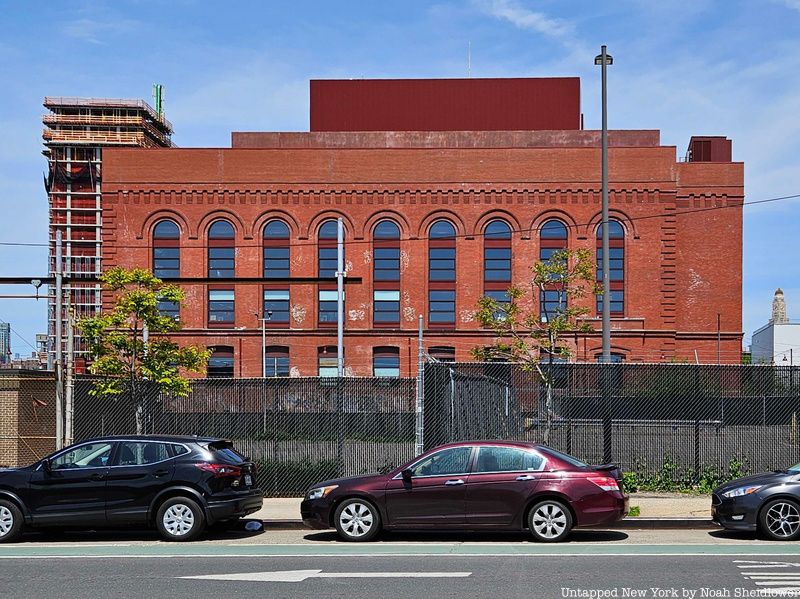
One of the most recognizable features of Gowanus is a building dubbed the Batcave, the former Brooklyn Rapid Transit Power Station that until recently stood abandoned. Standing right along the Gowanus Canal, the eight-story brick building dates back to 1904, designed by architect Thomas Edward Murray. As Brooklyn Rapid Transit expanded throughout the borough, the direct current system needed a more robust power system. To increase the power supply, the BRT agreed to move operations to centralized stations close to coal and water supplies that could more efficiently distribute current without bulky overhead cables. The power station in nearby Ridgewood had burned down, and a new site was quickly chosen by the Gowanus Canal at First Street and Third Avenue.
Construction was underway by 1901, though labor strikes and equipment shortages pushed construction further back and it was not finalized until 1903. At the time of its completion, the Romanesque Revival structure was one of the tallest in the neighborhood, packed with conveyors that moved coal from barges on the canal into storage. The BRT became the Brooklyn-Manhattan Transit Corporation, and as the years progressed, the Batcave deteriorated, and the boiler house was demolished in the 1950s. Five decades later, the Batcave attracted squatters who formed a community inside and by the nearby Carroll Street Bridge; the community continued to grow as more squatter communities across Brooklyn were evicted. The Batcave gained its current nickname perhaps because of the bats that lived there.
After over five years of restoration work, the Batcave has transformed into Powerhouse Arts, an arts center with manufacturing, exhibition, and educational spaces. At the time of restoration, just the Turbine Hall remained standing, though the Boiler Room was rebuilt with fabrication spaces to support the production of print, ceramics, and public art. The building houses workshops for print and ceramic production, which require access to the building’s rooftop extraction units. The Turbine Hall contains a Grand Hall for public and multi-use programming, such as exhibitions or performances. The building was also raised 13 feet to protect it from flooding and further deterioration.
2. Smith–Ninth Streets Station Was the Tallest Rapid Transit Station in the World Until 2022
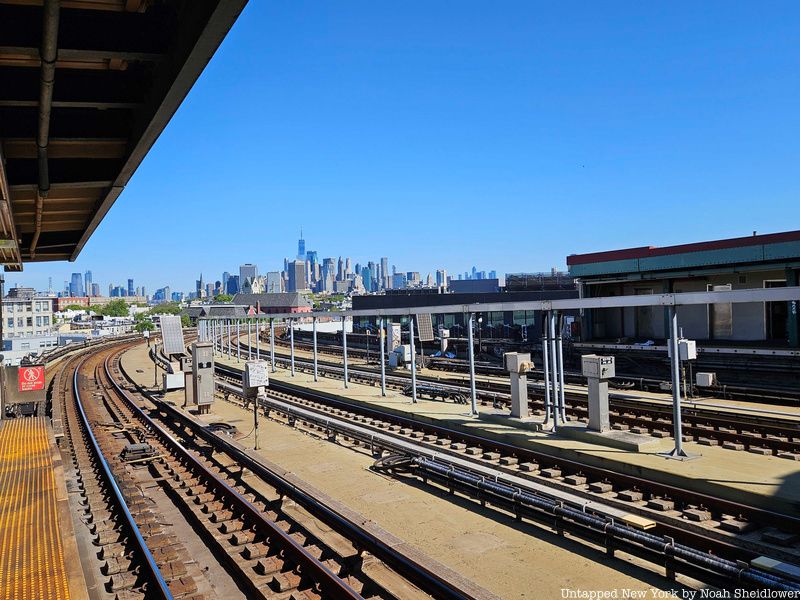
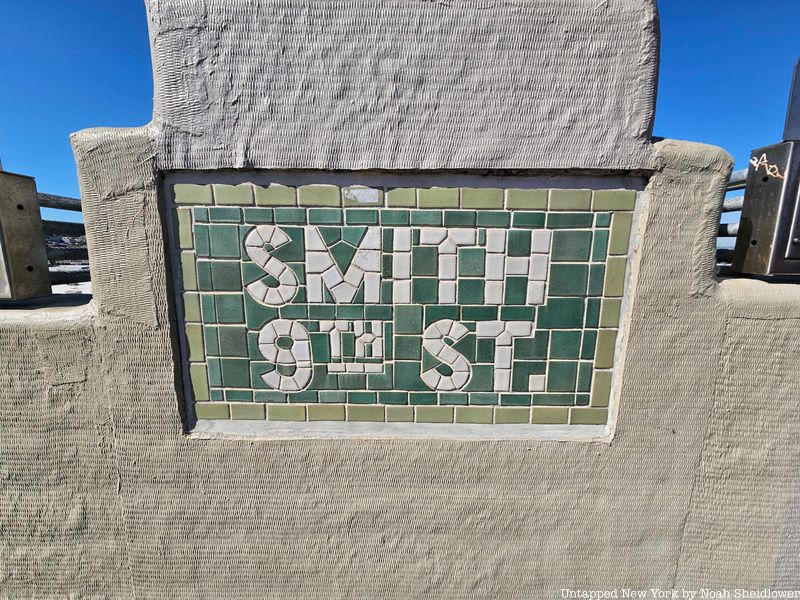
Until it was surpassed by the Chongqing Metro’s Hualongqiao station in 2022, Smith-Ninth Streets station was the highest rapid transit system in the world. The station is situated over the Gowanus Canal and stands at 87.5 feet above ground level. Served by the F and G trains, Smith-Ninth Streets station opened in 1933 and was originally served by the A train. To connect the rest of the city with Coney Island, the IND Culver Line was proposed to cross underneath the canal, though a viaduct over the canal was more economical, making it the only above-ground section of the original line.
After multiple reroutings (the E and D trains also served the station), the F and G became the regular trains. As trains zoomed by almost 100 feet above the ground, tall-mast ships sailed underneath. The station was built so the vertical-lift Ninth Street Bridge could safely open. Green mosaics with the name of the station still exist, and the viaduct underwent renovations beginning in 2007, as there was a significant danger of concrete falling onto the ground below.
3. The Green Lady of Brooklyn Lives in Gowanus
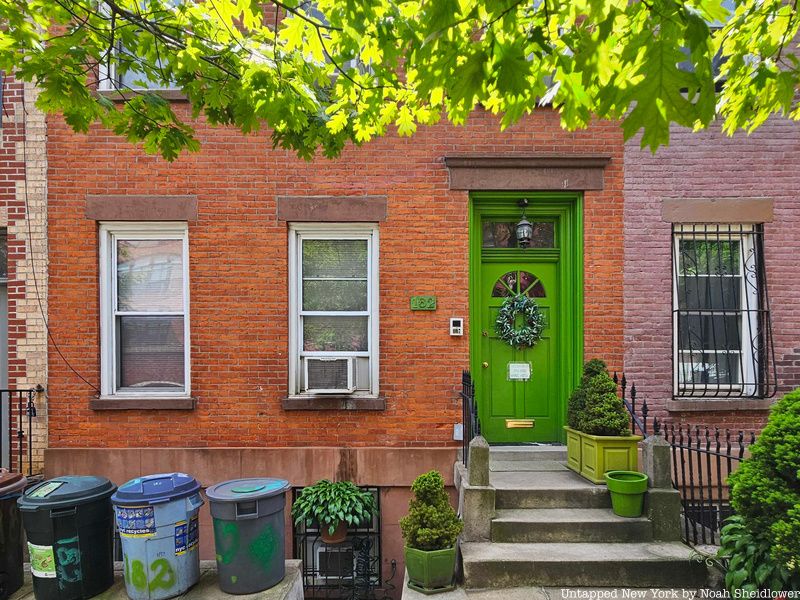
Elizabeth Sweetheart, also known as The Green Lady of Brooklyn, lives just on the border of Gowanus and Carroll Gardens. Sweetheart, who typically dresses in an all-green outfit, lives in a home on Nelson Street with a bright green door. Now 82, the Brooklynite was born in a coal mining town in Nova Scotia and raised in a log cabin by her grandparents, who taught her to paint and make clothing. After studying painting in college, she hitchhiked to New York City and began creating prints in the garment industry. The fabric designer eventually settled on a green aesthetic, dyeing her hair green to support the look.
For 15 years, she ran the SweetPea Design Studio, before transitioning to selling vintage fabrics from her collection. Sweetheart made prints for companies including Calvin Klein, Michael Kors, and Ralph Lauren. Her love for the color green was inspired by her childhood home by the Bay of Fundy. Since about 2000, she has donned green, with about 30 pairs of overalls all hand-dyed. Sweetheart sometimes invites people into her (unsurprisingly) green home, filled with green carpets, dishes, linens, towels, and even a green dog leash.
4. The Coignet Stone Company Building is the City’s Oldest Remaining Concrete Building
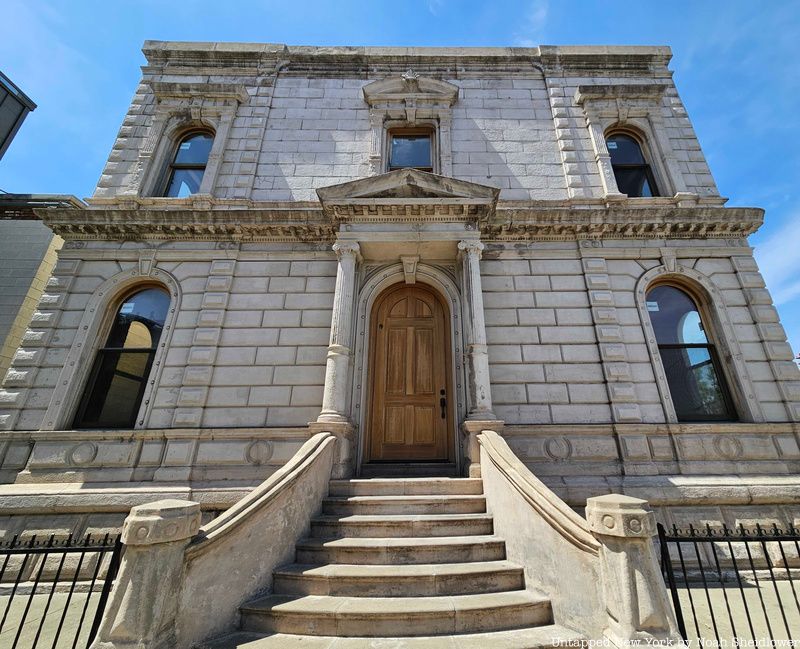
Before the neighborhood’s Whole Foods was built, the Coignet Stone Company Building stood alone in its architectural splendor. The building is the city’s oldest remaining concrete building, constructed between 1872 and 1873. The building was constructed as part of a five-acre concrete factory complex along the Gowanus Canal, standing two stories tall with a cast-stone facade. The factory was the first in the U.S. to manufacture a type of concrete patented by Frenchman François Coignet. Coignet’s mix could be molded instead of shaped with chisels and cutting tools, and it could be colored with a cement wash to give it the appearance of granite, brownstone, or whatever material was desired. The company shut down in 1882, just a few years after the building was complete, and it was then taken over by the Brooklyn Improvement Company. Much of the building’s interior began to deteriorate.
The Brooklyn Improvement Company was founded by Edwin Clark Litchfield, the namesake of the Litchfield Villa in Prospect Park (which at one point, was believed to be connected to the Coignet Building via an underground tunnel). Two Ionic-columned porticos topped by a pediment face the street while staircases lead up to rounded doors. On the second floor, rounded and rectangular windows are framed by columns and Italianate window heads. The ornate building was restored after being purchased by Whole Foods in 2005.
5. Carroll Street Bridge is the Nation’s Oldest Retractable Bridge
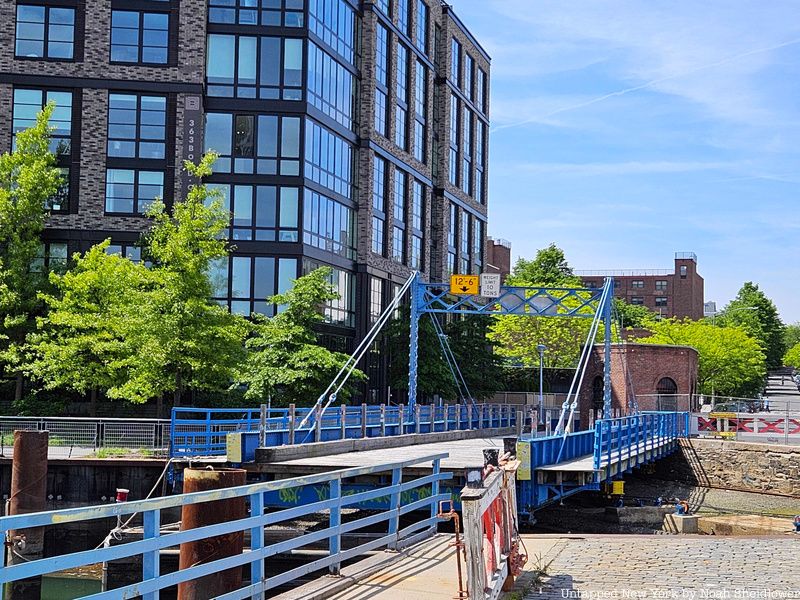
Though temporarily closed for testing and repairs, Carroll Street Bridge is one of the city’s last wooden bridges and the oldest of the country’s remaining retractable bridges. The 107-foot-long bridge crosses the Gowanus Canal and dates back to 1889. Edwin Litchfield’s plans to expand the canal left the swamp almost entirely dried out, which made it possible for development. The canal was originally crossed by six bridges, though the first Carroll Street Bridge closed in 1887. In its place was a retractable bridge that crossed a narrower portion of the canal and allowed boats to pass through. Robert van Buren, a descendant of Martin van Buren and Chief Engineer of the Bureau of Construction, oversaw the project. The bridge remained more or less the same for the first few decades of its existence.
However, come 1971, the city decided to permanently close the bridge, as it was too costly to continue operating. Just a month later, the bridge was reopened after massive resistance from residents, even though traffic was very light. In the 1980s, the bridge remained stuck in the open position for a few years, though it was restored in 1989. Many of the bridge’s historic features still remain, including a sign that reads, “Any Person Driving over this Bridge Faster than a Walk will be Subject to a Penalty of Five Dollars for Each Offence.”
6. Gowanus Used to Have a “Memorial Artyard”
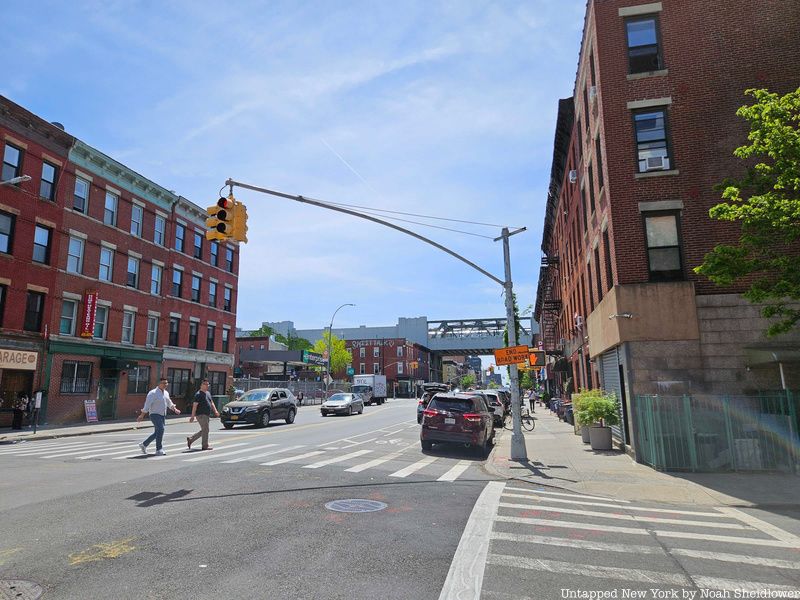
In the early 1980s, Gowanus was the site of indoor and outdoor art exhibitions put on by some of the most famous artists in New York City’s history. The Gowanus Memorial Artyard was founded in 1979 by Frank Shifreen, Michael Keene, and George Moore. It attracted leading artists who contributed sculpture and multimedia works. Shifreen began hosting art shows at his Brooklyn studio, which was housed in a former munitions factory that was partly unrented. The building’s location right near the Gowanus Canal and abandoned properties led the artists to plan art exhibitions, the first of which was called The Monumental Show in 1981. After receiving thousands of applications, the artists selected 150 people to create works of “monumental art” within a 20-foot by 20-foot space. Keith Haring and Carl Andre participated in the exhibition, which pulled in over 4,000 people on its first day but led to Shifreen’s arrest. The exhibition was controversial for its inclusion of a painting of Hitler. this inclusion caused widespread violence after Jewish leaders slashed paintings.
A year later, the organizers put on another exhibition, this time called The Monument Redefined. The exhibition was framed around social responsibility and included artists such as Christo, Chris Burden, Fred Wilson, and Vito Acconci. Posters were displayed throughout the city, and once again, hundreds of artists wanted to take part. Many artworks were displayed across 12 acres outdoors, in addition to two indoor spaces sponsored by the Department of Parks and Recreation, Con Edison, and many others. The same year, the exhibition Gowanus Canal Redefined was launched as an architectural competition. The organizers arranged for a $1,000 prize for the best proposal to revitalize the Gowanus Canal area. Ultimately, the group disbanded after the three exhibitions.
7. Remnants of a Historic Baseball stadium
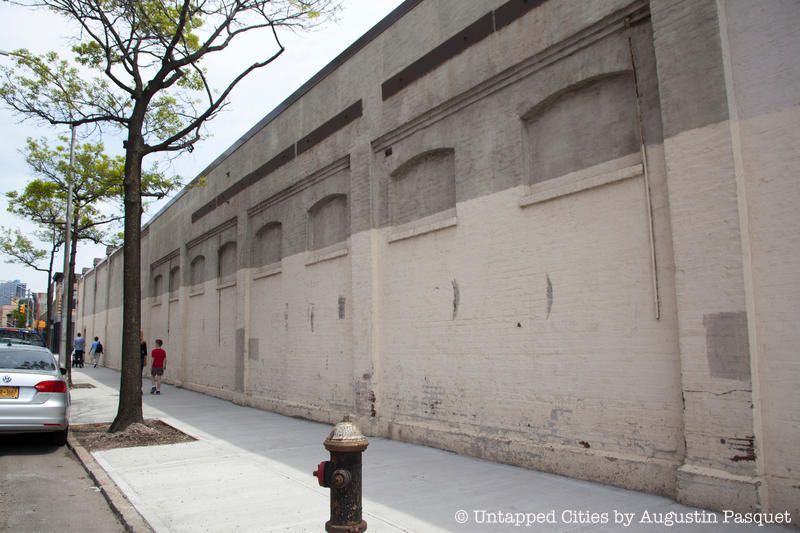
Located on 3rd Avenue in Gowanus, the Washington Park Wall is an unassuming white and gray structure that stands in a more industrial part of the neighborhood. The provenance of this wall and its connection to the Brooklyn Dodgers has long been debated. The Brooklyn Dodgers did play here at this site, at a stadium called Washington Park, between 3rd and 5th Streets and 4th and 5th Avenues. From 1883 to 1913, Brooklyn’s baseball club, which would become the Dodgers (at first named the Atlantics and then the Bridegrooms) played here at two different stadiums. The first was likely made of all wood and there are no remnants.
The team ultimately relocated to Brownsville, which was hard to get to for many fans. To mitigate this, a second Washington Park was constructed across the street from the first, seating nearly 19,000 people. The Brooklyn franchise, then known as the Superbas and then the Dodgers, moved into the ballpark in 1898, playing there for 15 seasons. The name Dodgers was derived from the Trolley Dodgers, inspired by the streetcars that operated by the ballpark. Baseball enthusiasts complained of the scents from the canal and factories nearby, though this did not deter people from attending games while Charlie Ebbets worked to develop a large stadium in Flatbush. After the Dodgers left, a new team called the Brooklyn Tip-Tops moved in, rebuilding the stadium in concrete and steel. A portion of the left-center field wall of the Tip-Top stadium, built in 1914, remains in Gowanus. Some believe that this wall may be a remnant of the 2nd Dodger’s stadium.
8. Gowanus Was Once Known as the Gaslight District

It’s perhaps unsurprising that the Gowanus Canal’s pollution stems back well over a century. However, it’s much less known that Gowanus at one point in its history was referred to as the Gaslight District. Around the 1860s, many manufactured gas plants were constructed throughout the neighborhood, converting coal transported down the canal into gas. Much of the leftover coal tar from these factories was dumped directly into the canal.
The canal had previously been used for oyster farming and milling, which declined amid Brooklyn’s rapid industrialization in the mid-1800s. The canal was deepened around this time so it could be used as a commercial waterway, which allowed as many as 100 ships to pass through daily. Amid the neighborhoods flour mills and cement factories were manufactured gas plants, which was not ideal considering the canal was only open at one end and thus could not flush away the toxic pollutants. It wasn’t until the late 1880s that the New York State Legislature appointed a commission to study the canal’s pollution.
9. Gowanus Canal is Known for its Sports, Animal, and Wartime History
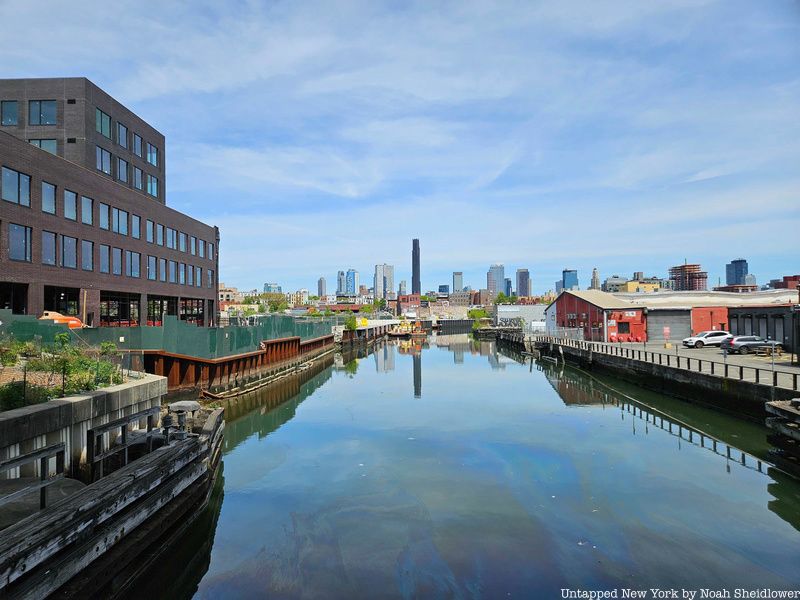
Gowanus Canal is arguably one of the strangest bodies of water in New York City. As one of the most polluted bodies of water in the Northeast (which dates back to the 1800s due to sewer backups), the canal expectedly has been the site of many attempts at rebirth. Use of the canal dates back to the mid-1600s when it provided a route that avoided the dangerous waters around Red Hook. The canal was inhabited by giant oysters, some of which may have measured over a foot long, that were traded throughout the colonies. Centuries later, the canal also was home to quite a few whales, the earliest recorded sighting of one going back to 1922, as well as dolphins and sharks.
The canal played a surprising role in the Revolutionary War as well; during the Battle of Brooklyn, an earthen wall was constructed that stretched from the canal to the current-day Brooklyn Navy Yard. Despite the wall, American forces still were defeated in the battle. Much of the fighting took place right near the canal. Some American soldiers were said to have swum naked in the canal, which disturbed many female locals. Near the canal is the Old Stone House, which also played a significant role in the war. The Old Stone House is also the birth place of ice baseball, a now-lost sport in which players would skate across frozen ponds and play baseball.
10. Five Gowanus Buildings Were All Landmarked Together in 2019
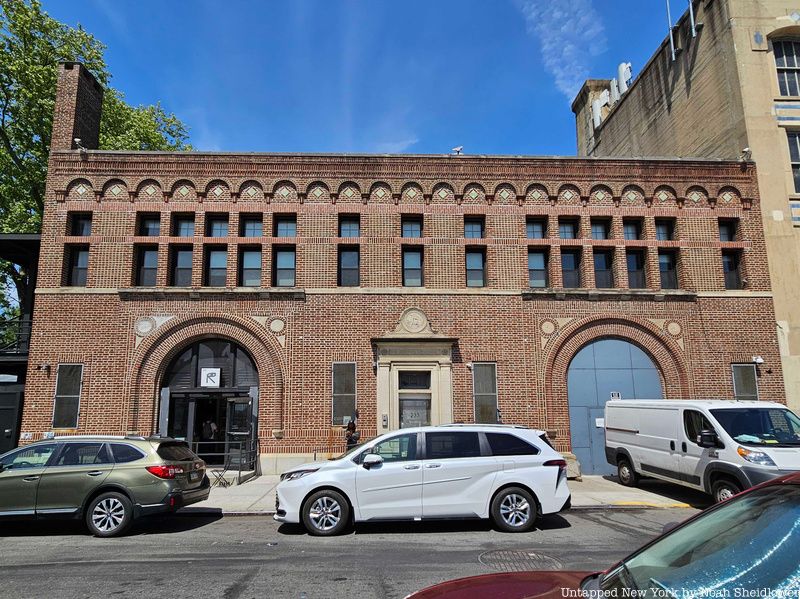
In 2019, five Gowanus buildings were all landmarked by the Landmarks Preservation Commission. The decision came after years of advocacy from local preservationists. The Batcave was perhaps the most notable on the list, though the landmarked Gowanus Canal Flushing Tunnel Pumping Station and GateHouse also has a fascinating history. The structure was built between 1909 and 1911 to help flush pollutants out of the Canal via a large propeller following several failed sewer projects. The brick and limestone building would pump water until the 1960s, when the propeller failed, after which it remained dormant until 1999. Completed a year earlier, the Montauk Paint Manufacturing Company Building was erected in 1908 and occupied by its namesake company, as well as the Dessau Cork Company and Diamond Decorative Leaf Company. The American Round Arch-style building, which has remained mostly intact, was a manufacturing hub for all sorts of paints, varnishes, and blacking.
Another historic building, the American Society for the Prevention of Cruelty to Animals (ASPCA) Brooklyn Office, Shelter, and Garage, was built in 1913 and expanded in 1922. The ASPCA, the nation’s first anti-cruelty organization, was founded in New York in 1866, and at the time, the building was the largest animal shelter in the country. The Neo-Romanesque building housed thousands of pets over the years while the building served as a shelter. The last landmarked building is the Somers Brothers Tin Box Factory, dated to around 1886, which employed over 150 people and used oil from the canal to power the factory. For a larger list of historic Gowanus properties, check out Six to Celebrate’s list.
Next, check out the Top 10 Secrets of Red Hook, Brooklyn!

